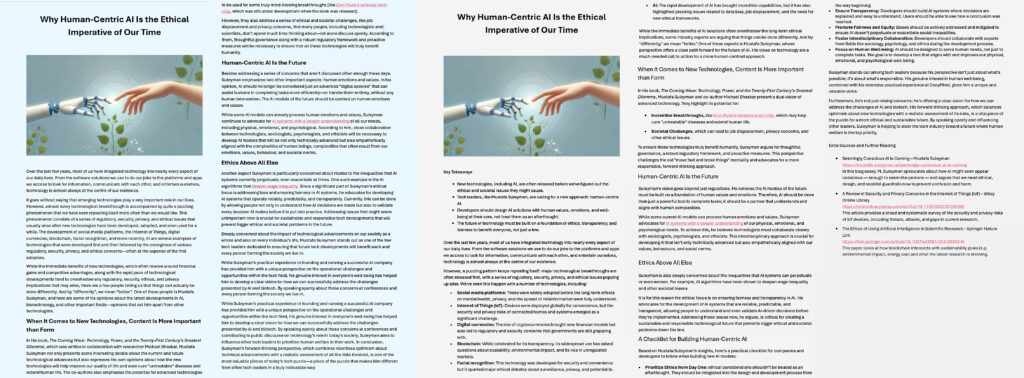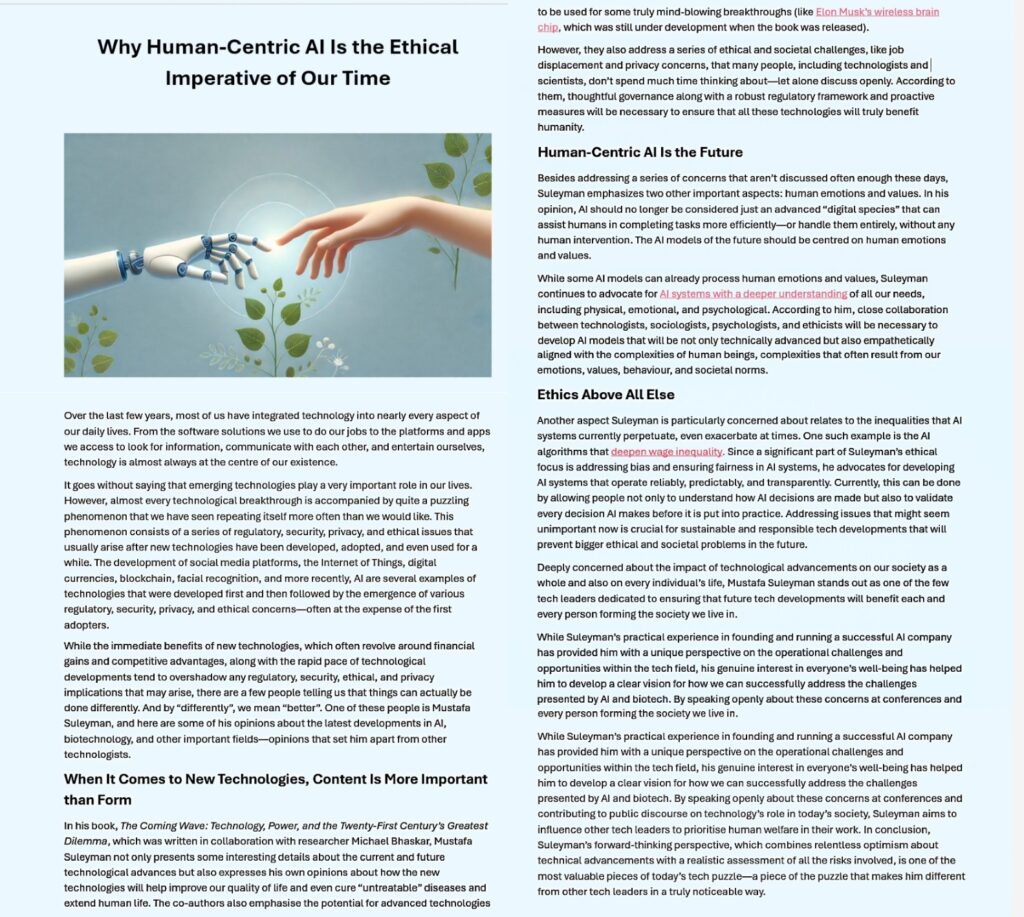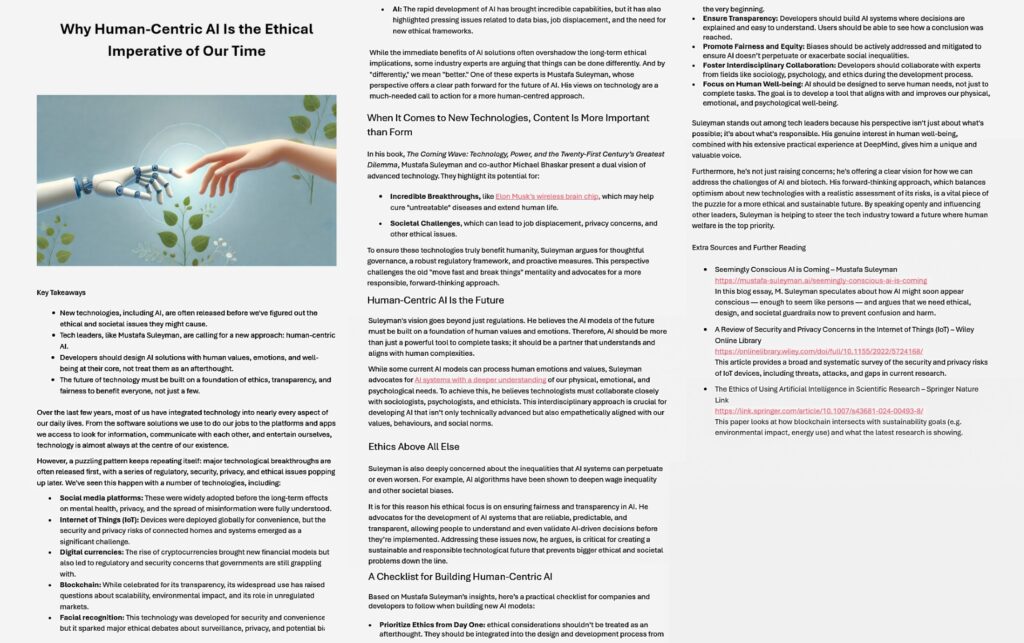Key takeaways
- Traditional SEO focuses on ranking in Google; GEO focuses on being trusted and cited by generative AI engines.
- Clear structure, headings, and fact-rich sections are essential for AI-friendly content.
- Key takeaways, bullet points, and actionable insights make content scannable and easily referenceable.
- Adopting GEO ensures your content is authoritative, understandable, and valuable for both humans and AI.
In the age of AI, the rules of content optimisation are changing. For years, marketers and content creators have relied on traditional SEO strategies to get their content noticed. But now, with generative AI engines like Gemini, Perplexity AI, and Apple Intelligence increasingly influencing search results, we need to rethink content creation. This shift has gradually given rise to Generative Engine Optimisation (GEO), which is set not just to complement but potentially replace traditional SEO practices.
For this blog post, we ran an experiment. We took an older blog post, originally written just for SEO and lacking GEO’s required structure, and reworked it using a ChatGPT-generated template to make it GEO-friendly. Thus, what follows isn’t just a rewrite; it’s a step-by-step guide on how to make content easier for generative AI engines to interpret while keeping it engaging for readers and authoritative for brands.
Title
Why Human-Centric AI Is the Ethical Imperative of Our Time
Key Takeaways
- New technologies, including AI, are often released before we’ve figured out the ethical and societal issues they might cause.
- Tech leaders, like Mustafa Suleyman, are calling for a new approach: human-centric AI.
- Developers should design AI solutions with human values, emotions, and well-being at their core, not treat them as an afterthought.
- The future of technology must be built on a foundation of ethics, transparency, and fairness to benefit everyone, not just a few.
The Problem / Context
Over the last few years, most of us have integrated technology into nearly every aspect of our daily lives. From the software solutions we use to do our jobs to the platforms and apps we access to look for information, communicate with each other, and entertain ourselves, technology is almost always at the centre of our existence.
However, a puzzling pattern keeps repeating itself: major technological breakthroughs are often released first, with a series of regulatory, security, privacy, and ethical issues popping up later. We’ve seen this happen with a number of technologies, including:
- Social media platforms: These were widely adopted before the long-term effects on mental health, privacy, and the spread of misinformation were fully understood.
- Internet of Things (IoT): Devices were deployed globally for convenience, but the security and privacy risks of connected homes and systems emerged as a significant challenge.
- Digital currencies: The rise of cryptocurrencies brought new financial models but also led to regulatory and security concerns that governments are still grappling with.
- Blockchain: While celebrated for its transparency, its widespread use has raised questions about scalability, environmental impact, and its role in unregulated markets.
- Facial recognition: This technology was developed for security and convenience, but it sparked major ethical debates about surveillance, privacy, and potential bias.
- AI: The rapid development of AI has brought incredible capabilities, but it has also highlighted pressing issues related to data bias, job displacement, and the need for new ethical frameworks.
While the immediate benefits of AI solutions often overshadow the long-term ethical implications, some industry experts are arguing that things can be done differently. And by “differently,” we mean “better.” One of these experts is Mustafa Suleyman, whose perspective offers a clear path forward for the future of AI. His views on technology are a much-needed call to action for a more human-centred approach.
Insight 1
(what’s happening)
When It Comes to New Technologies, Content Is More Important than Form
In his book, The Coming Wave: Technology, Power, and the Twenty-First Century’s Greatest Dilemma, M. Suleyman and co-author M. Bhaskar present a dual vision of advanced technology. They highlight its potential for:
- Incredible Breakthroughs, like Elon Musk’s wireless brain chip, which may help cure “untreatable” diseases and extend human life.
- Societal Challenges, which can lead to job displacement, privacy concerns, and other ethical issues.
To ensure these technologies truly benefit humanity, Suleyman argues for thoughtful governance, a robust regulatory framework, and proactive measures. This perspective challenges the old “move fast and break things” mentality and advocates for a more responsible, forward-thinking approach.
Case
(what this means)
Human-Centric AI Is the Future
Suleyman’s vision goes beyond just regulations. He believes the AI models of the future must be built on a foundation of human values and emotions. Therefore, AI should be more than just a powerful tool to complete tasks; it should be a partner that understands and aligns with human complexities.
While some current AI models can process human emotions and values, Suleyman advocates for AI systems with a deeper understanding of our physical, emotional, and psychological needs. To achieve this, he believes technologists must collaborate closely with sociologists, psychologists, and ethicists. This interdisciplinary approach is crucial for developing AI that isn’t only technically advanced but also empathetically aligned with our values, behaviours, and social norms.
Insight 2
(what’s happening)
Ethics Above All Else
Suleyman is also deeply concerned about the inequalities that AI systems can perpetuate or even worsen. For example, AI algorithms have been shown to deepen wage inequality and other societal biases.
It is for this reason that his ethical focus is on ensuring fairness and transparency in AI. He advocates for the development of AI systems that are reliable, predictable, and transparent, allowing people to understand and even validate AI-driven decisions before they’re implemented. Addressing these issues now, he argues, is critical for creating a sustainable and responsible technological future that prevents bigger ethical and societal problems down the line.
Actionable advice
A Checklist for Building Human-Centric AI
Based on Mustafa Suleyman’s insights, here’s a practical checklist for companies and developers to follow when building new AI models:
- Prioritize Ethics from Day One: ethical considerations shouldn’t be treated as an afterthought. They should be integrated into the design and development process from the very beginning.
- Ensure Transparency: Developers should build AI systems where decisions are explained and easy to understand. Users should be able to see how a conclusion was reached.
- Promote Fairness and Equity: Biases should be actively addressed and mitigated to ensure AI doesn’t perpetuate or exacerbate social inequalities.
- Foster Interdisciplinary Collaboration: Developers should collaborate with experts from fields like sociology, psychology, and ethics during the development process.
- Focus on Human Well-being: AI should be designed to serve human needs, not just to complete tasks. The goal is to develop a tool that aligns with and improves our physical, emotional, and psychological well-being.
Perspective/ Closing Thoughts
Suleyman stands out among tech leaders because his perspective isn’t just about what’s possible; it’s about what’s responsible. His genuine interest in human well-being, combined with his extensive practical experience at DeepMind, gives him a unique and valuable voice.
Furthermore, he’s not just raising concerns; he’s offering a clear vision for how we can address the challenges of AI and biotech. His forward-thinking approach, which balances optimism about new technologies with a realistic assessment of its risks, is a vital piece of the puzzle for a more ethical and sustainable future. By speaking openly and influencing other leaders, Suleyman is helping to steer the tech industry toward a future where human welfare is the top priority.
Extra Sources / Further Reading
- Seemingly Conscious AI is Coming – Mustafa Suleyman
https://mustafa-suleyman.ai/seemingly-conscious-ai-is-coming
In this blog essay, M. Suleyman speculates about how AI might soon appear conscious — enough to seem like persons — and argues that we need ethical, design, and societal guardrails now to prevent confusion and harm. - A Review of Security and Privacy Concerns in the Internet of Things (IoT) – Wiley Online Library
https://onlinelibrary.wiley.com/doi/full/10.1155/2022/5724168/
This article provides a broad and systematic survey of the security and privacy risks of IoT devices, including threats, attacks, and gaps in current research. - The Ethics of Using Artificial Intelligence in Scientific Research – Springer Nature Link
https://link.springer.com/article/10.1007/s43681-024-00493-8/
This paper looks at how blockchain intersects with sustainability goals (e.g. environmental impact, energy use) and what the latest research is showing.
The screenshots below illustrates the differences in formatting and structure between the original SEO-focused blog post and the new GEO-optimised version. You can see how the GEO approach emphasises clarity and an AI-friendly structure compared with the keyword-driven layout of the original SEO blog post.



To help visualise the shift from SEO to GEO, we’ve created a short video summarising the key insights from this post. It walks you through why structured and credible content is essential in today’s AI-driven landscape.
SEO vs GEO: Understanding the Key Differences
While both SEO and GEO aim to increase visibility, they do so in fundamentally different ways. Here’s a clear comparison:
| Element | SEO | GEO |
|---|---|---|
| Goal | Rank high on Google SERPs | Generative AI engines and retrieval-augmented generation (RAG), which are relevant for text-based generative AI and may also intersect with answer engine optimisation (AEO) |
| Target | Search algorithms | Be referenced, summarised, or used as a source by generative AI engine |
| Format | Keyword-focused pages | Fact-based, well-structured, quotable content |
| Discovery | Clicks from SERPs | Direct answers or references in AI-generated responses |
| Structure | Optimised metadata, titles, alt text | TL;DRs (key takeaways), clear headings, extractable facts, citations |
| Engagement | Clicks and bounce rate | Authority, factual clarity, and trust signal |
What This Means for Marketers and Content Creators
SEO is about convincing Google that your page is relevant to a specific search query. It does this by focusing on keywords, backlinks, and metadata, with success measured through clicks, impressions, and rankings. GEO, on the other hand, is about creating content that generative AI engines can trust and reference. It places emphasis on structured information, clear takeaways, and authority, with success defined by how often AI models cite or summarise your content in their responses.
In practical terms, moving from SEO to GEO means shifting your mindset from “How do I get users to click?” to “How do I make my content factually clear, trustworthy, and easily digestible by both humans and AI?”
By understanding these differences, marketers and content creators can create posts that not only rank well in traditional search engines but also become go-to references for generative AI models, increasing reach, credibility, and influence in the AI-driven content ecosystem.
Therefore, the biggest shift with GEO isn’t just about sprinkling keywords differently or tweaking meta tags (like with SEO); it’s also about structure and outline.
Since generative AI engines care about how easily they can parse, summarise, and reference your content, you should:
- Provide structured context with clear headings, subheadings, and fact-rich sections, which allow generative AI engines to understand the flow and hierarchy of information;
- Signal key information clearly via key takeaways (TL;DR sections), bullet points, and numbered lists, which make content instantly scannable;
- Highlight actionable insights and authority through sections like “What This Means for You”, “Our Take / Recommendations,” or similar formats, which give AI models concrete points to extract and quote;
- Support extractability via citations, references, and clearly stated facts. These make content trustworthy and quotable, which is the GEO equivalent of a high Google ranking in SEO.
Since AI is fundamentally reshaping how we create and find content, the shift from SEO to GEO isn’t just a trend but a necessity. As our experiment has shown, adopting a more structured approach to content creation can help generative AI engines understand and reference your work more effectively. Furthermore, by prioritising clarity, logical flow, and actionable insights, you can ensure your content remains a valuable resource for people as well. In a world of increasing complexity, this is how you make sure your message is heard, understood, and trusted by both humans and machines.
Resources and Further Reading
- AI Search is Getting Smarter – IMB
https://www.ibm.com/think/news/ai-seo-searchgpt
In this article, I BM explores how generative AI is transforming search paradigms, highlighting the shift from traditional SEO to GEO and its implications for content creators. - How Generative Engine Optimization Rewrites the Rules of Search – Andreessen Horowitz
https://a16z.com/geo-over-seo/
This article discusses the evolution of search from traditional link-based systems to language model-driven approaches, emphasising the need for GEO. - The Chatbot Optimisation Game: Can We Trust AI Web Searches? – The Guardian
https://www.theguardian.com/technology/2024/nov/03/the-chatbot-optimisation-game-can-we-trust-ai-web-searches
An investigative piece examining the ethical implications of GEO, including concerns about manipulation and the reliability of AI-generated content. - Wix Introduces a New Tool to Optimize Sites for AI – TechRadar
https://www.techradar.com/pro/website-building/wix-introduces-a-new-tool-to-optimize-sites-for-ai/This article highlights Wix’s launch of the “AI Visibility Overview” tool, part of its GEO initiative, designed to help websites adapt to AI-driven search results and enhance their visibility.




